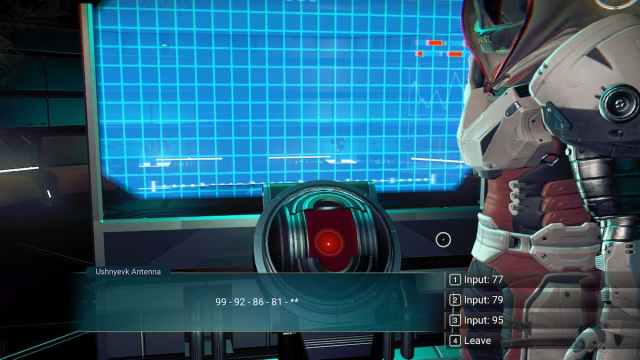The world of No Man’s Sky hides many secrets and locations to explore. Some of them you can find after solving a puzzle in the Transmission Tower, which is one of the POIs on any planet.
These puzzles throw a bunch of numbers at you that might be confusing at first, so here are all the Transmission Towers puzzles in NMS and how to solve them.
All answers to NMS Transmission Towers

You can find Transmission Towers randomly on any planet or by using a Planetary Chart that leads to the inhabited outpost (red building icon). In the tower, there’s always a terminal with a sequence puzzle.
You have to choose the correct number out of the three options, or you’ll be locked out and won’t be able to get coordinates for a linked point of interest.
Here are all the Transmission Tower puzzles we managed to find and their answers:
| Sequence | Answer |
|---|---|
| 99 – 92 – 86 – 81 – … | 77 |
| 5920 – 9205 – 2059- … | 0592 |
| 2 – 4 – 12 – 48 – 240 – … | 1440 |
| 17 – 33 – 65 – 129 – … | 257 |
| 80 – 71 – 63 – 56 – … | 50 |
| 5040 – 720 – 120 – 24 – … | 6 |
| 5 – 14 – 41 – 122 – … | 365 |
| 1 – 5 – 3 – 7 – 5 – 9 – … | 7 |
| 3 – 5 – 8 – 13 – 21 – … | 34 |
| 56 – 59 – 63 – 68 – 74 – … | 81 |
| 1 – 3 – 4 – 7 – 11 – 18 – … | 29 |
| 1 – 2 – 6 – 24 – 120 – … | 720 |
How to solve NMS Transmission Towers: Explanation
The solutions for these puzzles are different, but in every case, you have to choose a number that follows the logic of the sequence. Below, you can find all the types of puzzles we’ve encountered so far and the solutions behind them.
Subtract a decreasing number
In this sequence, every number equals the previous entry minus a decreasing number. For example, in the sequence “99 – 92 – 86 – 81 – …,” 99-7=92, then 92-6=86, and so on.
Number combinations
The “5920 – 9205 – 2059- …” sequence lists different combinations with the numbers five, nine, two, and zero. If you look at it as a loop of numbers, the order doesn’t change (e.g., two is always after nine), and the answer is simply a number that isn’t yet in the sequence.
Multiply by an increasing number
This type is similar to the first one, except every next entry is a previous entry multiplied by an increasing number. For example, in sequence “2 – 4 – 12 – 48 – 240 – …“, 2×2=4, 4×3=12, which means you have to multiply 12 by four to get the next entry, then multiply the result by five to get the next, and so on.
Add the last number minus one
To get the next entry in this puzzle, you have to add the last number and subtract one. For example, in the sequence “17 – 33 – 65 – 129 – …,” 17+16=33 (where 16=17-1), then 33+32=65 (where 32=33-1), and so on.
Divide by a decreasing number
Following a similar logic to the rest of the puzzles, to get the next number in this sequence, you have to divide it by a decreasing number. The sequence “5040 – 720 – 120 – 24 – …” starts by dividing 5040 by seven to get 720, then dividing 720 by six to get 120, and so on.
Multiply by a number minus one
In the sequence “5 – 14 – 41 – 122 – …,” every following number is the last number multiplied by three minus one. For example, 122=41×3-1, and to find the answer, you have to multiply 122 by three and subtract one.
Add a number then subtract a number
Sequence “1 – 5 – 3 – 7 – 5 – 9 – …” is a bit more complicated. Every entry alternates between two actions: Add four and subtract two. 1+4=5, 5-2=3, and so on throughout the sequence.
Add the previous number
This one is pretty simple. To get an answer in a sequence like “3 – 5 – 8 – 13 – 21 – …,” you have to add the previous entry to the last number. In this case, the number 21 is 13+8, and 13 is 8+5. The same goes for the sequence 1 – 3 – 4 – 7 – 11 – 18 – …
Add an increasing number
This is also an easy one compared to the rest. In a sequence like “56 – 59 – 63 – 68 – 74 – …,” to get the next entry, you add an increasing number. So 56+3=59, 59+4=63, and then to get the next entry, you have to add five to 63.






Published: Aug 13, 2024 12:37 pm